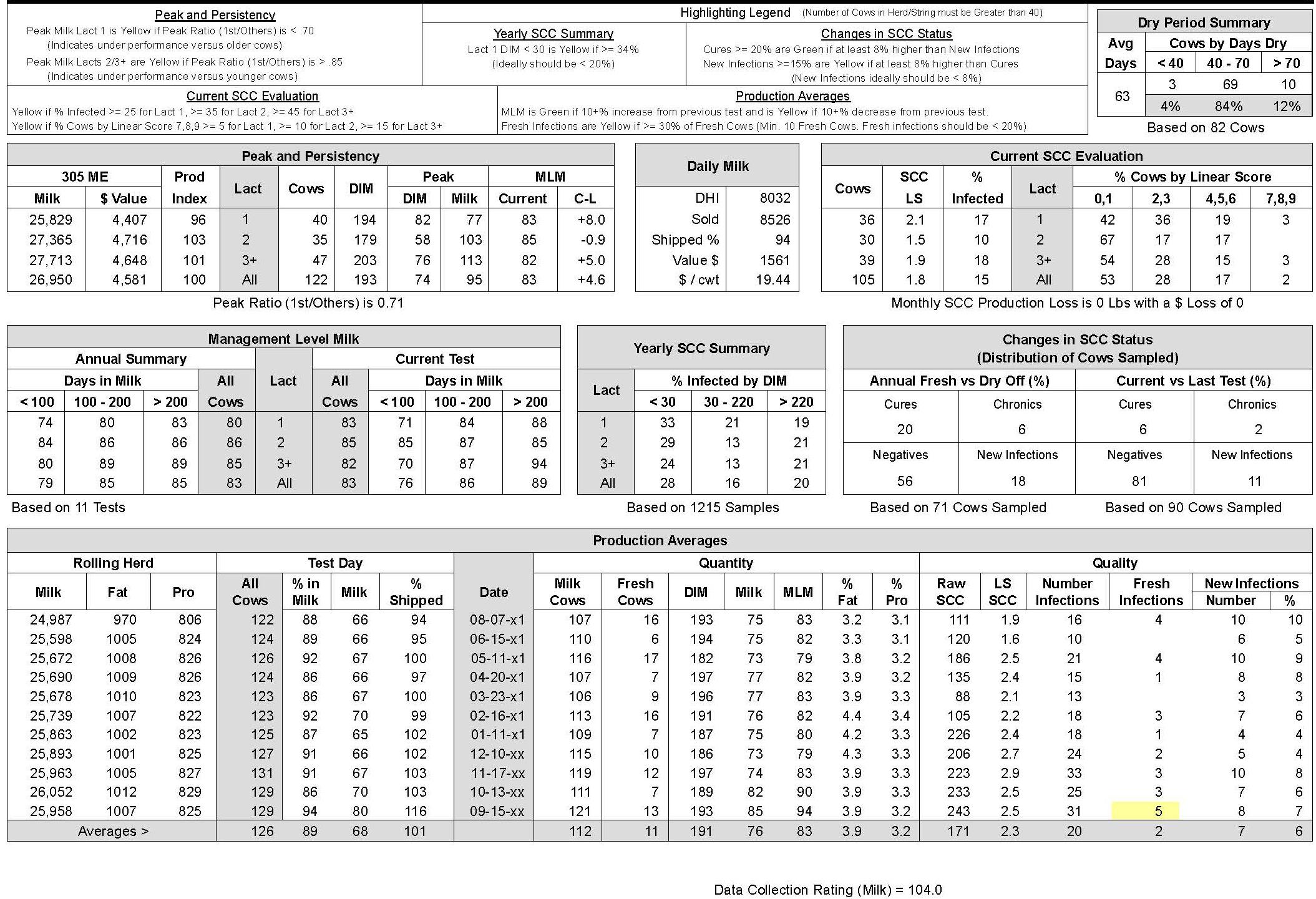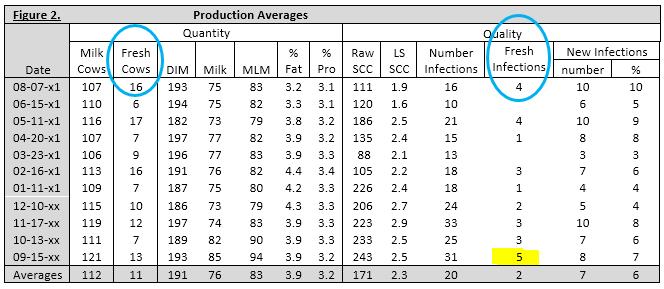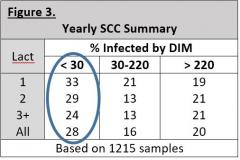How Well Are Your Dairy Cows Performing When It Comes to Milk Quality? Part 1: Fresh Cows
How Well Are Your Dairy Cows Performing When It Comes to Milk Quality?
Part 1: Fresh Cows
Dairy bulk tank somatic cell counts (SCC) are used to assess overall milk quality of a herd since a relationship exists between somatic cell counts and mammary health. However, bulk tank SCC do not help detect individual cases of subclinical mastitis (no visible signs of mastitis) that contribute to elevated herd somatic cell counts. Routine sampling of milk from individual cows, testing these milk samples to determine SCC (or another measure to assess milk quality), and summarizing these data for a herd helps determine how well prevention programs are working and allows one to target and change management practices within groups or sets of individual cows to correct issues.
Assimilating data related to a mastitis prevention program starts when managers review somatic cell counts for individual cows (i.e. Lab Hot Sheet after DHI test) and determine the cows currently with the highest somatic cell counts. Cows with a SCC greater than 200,000 are considered to have subclinical mastitis even though they may or may not show visible signs of an infection. Reviewing these data does help identify cows that have recently increased in somatic cell count or remain high, but does not help identify areas of concern within management protocols. To achieve this management goal, data need to be summarized for groups of cows and over time, such as that achieved on DHI summary reports or reports from software associated with milk meters or robotic milking systems.
For herds processed through DRMS, managers can select either DHI-202 (Herd summary report) or DHI-302 (Consultant report) herd summaries or both for an additional small fee. The DHI-302 report summarizes data allowing one to review fresh cow and mastitis prevention protocols at a glance. For this discussion, data provided in reports available through DRMS will be used, specifically the DHI-302.
Evaluating Milk Quality of Fresh Cows
Health of dairy cows within the first 2 to 4 weeks after calving is a critical determinant of milk production and reproductive performance for the entire lactation and directly impacts survival within the dairy herd. Since a cow’s immune system naturally is compromised just before and within the first 2 weeks after calving, these cows are more susceptible to mastitis within this time frame. Clinical, as well as subclinical, mastitis results in less milk production over a lactation as milk secreting cells are damaged. Studies have suggested that reproductive efficiency is negatively impacted in cows with both clinical and subclinical mastitis. Evaluating the prevalence of cows with mastitis (greater than 200,000 cells/mL SCC) within the first 30 days after calving, can help manage this group of cows and decrease the incidence of mastitis and its impacts on reproductive performance.
|
Figure 1: The DHI-302 Herd Summary allows review at a glance whether mastitis prevention protocols are working. Percentage of fresh cows with SCC greater than 200,000 for each test date (See Figure 2)For each test, this report summarizes the number of fresh cows with a higher than 200,000 cells/mL SCC. One can calculate the percentage of fresh cows that have a SCC greater than or equal to 200,000 by dividing the number of fresh infections by the number of fresh cows. In this example report, 25% of the fresh cows (4 cows with fresh infections out of 16 fresh cows) have a SCC greater than 200,000 on the first test day after calving for the test dated 8-07-x1. Ideally, one would like to see less than 20% of fresh cows with a high SCC on the first test after calving. When more than 30% of the fresh cows are flagged as having a SCC over 200,000, the number of fresh infections is highlighted in yellow. On this report, the 9-15-xx test date had greater than the 30% of cows freshening with an elevated SCC. This part of the report allows one to detect a problem with either dry cow or just-fresh cow management programs within the last test period and to make corrections when necessary. One would then evaluate the environment around the time of calving as well as dry cow, mastitis prevention protocols, i.e effectiveness of dry cow treatments. Yearly SCC summary showing the percentage of cows by lactation number infected within the first 30 days in milk: (See Figure 3)
For the current year, the percentage of first, second, or third+ cows within the first 30 days in milk (DIM) with an elevated SCC is calculated. These values reflect all cows who have completed their first test after calving within the past year. Ideally, less than 20% of cows should be infected for any of the categories reflecting the defined ranges for number of DIM. First-lactation heifers should be lower in SCC and in percentage infected than mature cows. In this example, 33% of the first calf heifers are coming fresh with an elevated SCC and this percentage drops after the first test. Similar trends are seen with the mature cows SCC over the past year. This allows one to consider if fly control in heifers and environment pre-calving is optimum as well as if the best feeding program for optimum immunity against mastitis organisms is provided to name just a few areas to evaluate in this example herd. Changes in SCC status from dry off to the first test after calving: (See Figure 4)
These data illustrate over the past year how well mastitis prevention protocols at dry off (dry cow therapy and procedures at dry off) and around the time of calving (environment around time of calving) are preventing mastitis. The percentage of cures should be greater than the percentage of chronic cows. The percentage of negatives or consistently clean cows should ideally be greater than 75% and the percentage of cows with new infections less than 8%. This report can also be generated in PCDART where the cows in each grouping can be identified and their individual SCC data reviewed. In this example, the percentage of cows negative for subclinical mastitis is lower than ideal with the number of new infections higher than ideal. These data again point to re-evaluating management of second lactation and mature cows at dry off and around the time of calving. In a separate article ("How Well Are Your Dairy Cows Performing When it Comes to Milk Quality: Part 2- Evaluating Cows in the Milking Herd"), we will look at how to use this report to evaluate mastitis prevention programs for the milking herd. |
Authors: Donna M. Amaral-Phillips and Kas Ingawa (DRMS)




